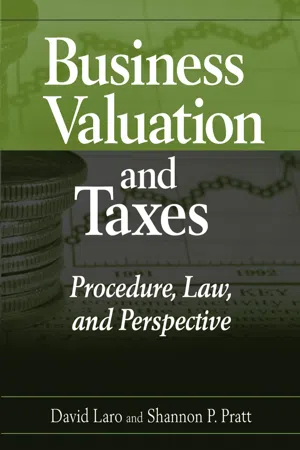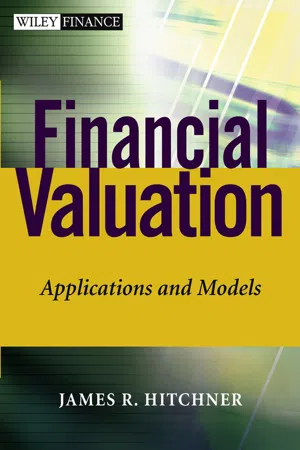Business
Option Valuation
Option valuation is the process of determining the fair value of an option, which gives the holder the right to buy or sell an underlying asset at a specified price within a certain time frame. Various models, such as the Black-Scholes model, are used to calculate option values by considering factors like the underlying asset's price, volatility, time to expiration, and interest rates.
Written by Perlego with AI-assistance
Related key terms
1 of 5
7 Key excerpts on "Option Valuation"
- eBook - PDF
Business Valuation and Taxes
Procedure, Law, and Perspective
- Shannon P. Pratt, David Laro(Authors)
- 2005(Publication Date)
- Wiley(Publisher)
They are rarely easy to value. Options present a tricky problem for valuers as they are usually not publicly traded, and vary greatly in their terms and features. The variety of options one will encounter is limited only by the imagination of the people who create them, and each option presents unique features that can alter value. Despite unfavorable tax treatment, options have ex- panded beyond Hollywood to become one of the most popular forms of derivative invest- ment on the market. Stating the basic rule for valuing options is easy, while applying it in practice is anything but. We will consider some general rules of valuation and apply them in three specific situa- tions: when options are received as compensation, distributed to owners of a corporation, or received as a gift. GENERAL PRINCIPLES OF Option Valuation Fair market value of options is determined using the same basic rules as other property. Prop- erty should be valued at the price at which it would change hands between a willing buyer and willing seller, neither being under any compulsion to buy or sell, both having reasonable knowledge of relevant facts. 2 This includes a consideration of all relevant factors. 3 There are generally three acceptable approaches for determining fair market value: 1. The market approach 2. The income approach 3. The asset-based approach Note that the same problems discussed in Chapter 1 are present here: There are substan- tive differences between the Treasury’s definition of fair market value and the AICPA’s defin- ition of fair value. These differences are even more complex to resolve following the sweeping changes incorporated in Statements of Financial Accounting Standards 123 and 133, which require firms to recognize, in the year incurred, gains or losses on nonhedge deriv- atives’ fair value. - eBook - PDF
- Yuanyun Kang(Author)
- 2009(Publication Date)
- Diplomica Verlag(Publisher)
As Trigeorgis pointed out, traditional valuation methods are unable to capture the value of operating options properly, because of their discretionary asymmetric nature and their dependence on future events that are uncertain at the time of the initial decision 36 . Due to the shortcomings of the traditional valuing methods in the quantitative analysis of strategic or flexible investment projects, strategic decisions in corporate practice such as product innovation have typically been based on intuition, good feeling or other subjective considerations. A new method of investment valuation that permits the evaluation of intangible or strategic assets to make corporate strategy measurable is therefore required. 35 Trigeorgis, L.1997. Real Options – Managerial Flexibility and Strategy in Resource Allocation, p.155 36 Trigeorgis, L.1997. Real Options – Managerial Flexibility and Strategy in Resource Allocation, p.154 Real Option Valuation of Product Innovation 26 3. Introduction of Real Option Valuation 3.1. The Definition of an option Option is a definition in capital budgeting. An option 37 provides the buyer ( holder ) the right (but not the obligation) to exercise by buying or selling an asset at a set price (called an exercise price or a strike price) on (European style option) or before (American style option) a future date (the expiration date). An option is often classified as call option and put option. Exercise price 38 is the amount of money invested to exercise the option if you are “buying” the asset with a call option, or the amount of money received if you are “selling” it with a put option. Underlying asset 39 for a financial option is a security such as a share of common stock or a bond. For example, in a stock option to buy 100 shares of BlackBerry at EUR 140 at the end of year 2007, the BlackBerry share is the underlying asset. - No longer available |Learn more
- (Author)
- 2014(Publication Date)
- Orange Apple(Publisher)
Valuations are required in many contexts including investment analysis, capital budgeting, merger and acquisition transactions, financial reporting, taxable events to determine the proper tax liability, and in litigation. ____________________ WORLD TECHNOLOGIES ____________________ Valuation overview Valuation of financial assets is done using one or more of these types of models: 1. Discounted Cash Flows determine the value by estimating the expected future earnings from owning the asset discounted to their present value. 2. Relative value models determine the value based on the market prices of similar assets. 3. Option pricing models are used for certain types of financial assets (e.g., warrants, put options, call options, employee stock options, investments with embedded options such as a callable bond) and are a complex present value model. The most common option pricing models are the Black-Scholes-Merton models and lattice models. Common terms for the value of an asset or liability are fair market value, fair value, and intrinsic value. The meanings of these terms differ. The most common sets market price. For instance, when an analyst believes a stock's intrinsic value is greater than its market price, the analyst makes a buy recommendation and vice versa. Moreover, an asset's intrinsic value may be subject to personal opinion and vary among analysts. Business valuation Businesses or fractional interests in businesses may be valued for various purposes such as mergers and acquisitions, sale of securities, and taxable events. An accurate valuation of privately owned companies largely depends on the reliability of the firm's historic financial information. Public company financial statements are audited by Certified Public Accountants (US), Chartered Certified Accountants (ACCA) or Chartered Accountants (UK and Canada) and overseen by a government regulator. - eBook - PDF
Financial Valuation
Applications and Models
- James R. Hitchner(Author)
- 2003(Publication Date)
- Wiley(Publisher)
Management often encounters the need to apply real options in strategic deci- sions: • Timing. Delay the decision until more information is available. • Flexibility. Present value of the ability to switch to a different course of action as future circumstances dictate (e.g., a cogeneration power plant that can switch between oil and coal, depending on market prices). • Operating. The value of the ability to expand on contract operations. • Growth. The current value of future payoffs. An example is the value of Amazon.com generated by its potential to sell other products in addition to books. Traditional discounted cash flow models may not determine the value of flexible managerial decision making. ValTip Real options is a managerial decision making tool that utilizes financial option pricing models such as the Black-Scholes and applies them to “real” rather than just specific financial decisions. ValTip Option Basics An option provides the investor with the right, but not the obligation, to buy or sell a specific amount of an underlying asset during a specified period of time (see Chapter 23, “I: Valuation Issues Related to Stock Options”). The right to buy an asset is called a call option. The right to sell an asset is called a put option. The value of an option is determined by a number of variables: • Current value of the underlying asset • Volatility in the value of the underlying asset • Strike exercise price • Time to expiration • Risk-free rate Underlying Asset A key component of the value of an option is the current value of the underlying asset. Changes in the value of the underlying asset affects the value of the option on that asset. A call option gives the holder the right to buy an asset at a fixed price within a fixed time period. Therefore, an increase in the value of the underlying asset increases the value of the call option. A put option gives the holder the right to sell an asset at a fixed price within a fixed time period. - eBook - PDF
Recent Trends in Valuation
From Strategy to Value
- Luc Keuleneer, Willem Verhoog, Luc Keuleneer, Willem Verhoog(Authors)
- 2005(Publication Date)
- Wiley(Publisher)
These option values can be determined in a manner that is similar to the valuation techniques for financial options. A summary of the models for Option Valuation is described by Amram and Kulatilaka (1999). There are three categories of solution methods: by solving the partial differential equation (for example, the Black and Scholes model), dynamic programming (for example, the binomial model of option valua- tion) and by means of simulations (for example, Monte Carlo simula- tions). The value of all the options that are at a company’s disposal is, however, not equal to the sum of the values of the individual options because they interact. 11 As a general rule, binomial trees are more applic- able in real Option Valuation than the Black and Scholes formula, as they allow the valuation of various options simultaneously and put less restric- tions on the distribution of the underlying value. In Table 2.1, the corresponding parameters, 12 which are important for real options and financial options, are compared to each other. Because of these parallels, real options can be valued in the same way as options on financial assets. An option on a share gives the right to buy (call option) or to sell (put option) an underlying share during a specific period (American option) or at the end of that period (European option) at a predetermined price. As this concerns a ‘right’, the value of an option can never be negative, because then the holder of the option does not exercise the right. This accounts for the positive influence of risk (volatility) in the valuation of options: the ‘loss’ is limited to a zero value; the potential profit is very high and increases as uncertainty increases. - eBook - PDF
Financial Analysis, Planning and Forecasting
Theory and Application
- Alice C Lee, John C Lee;Cheng F Lee;;(Authors)
- 2009(Publication Date)
- WSPC(Publisher)
In viewing a firm’s securities as options, we need to evaluate the interdependencies of binds and stocks. As we have seen, a bond’s price is the present value of future interest and principal payments, and a stock’s Option Pricing Theory and Firm Valuation 369 price is determined by future dividends. The contingent-claims approach to security valuation differs in that it considers the valuation of all of the firm’s classes of securities simultaneously. Bonds and stocks are valued in terms of the value placed on the firm’s assets, that is, their value is contingent on the firm’s assets or investments. Banz and Miller (1978) developed an approach to making capital bud-geting decisions based on a contingent claims framework. They created a method for calculating the NPV of an investment based on estimates derived from using an Option Valuation model. In this chapter, we con-sider the question of Option Valuation and how options are used to make financial management decisions. However, before doing so, we must become acquainted with some of the terminologies of options trading. There are two basic types of options: puts and calls. A call gives the holder the right to buy a particular number of shares of a designated common stock at a specified price, called the exercise price (or strike price), on or before a given date, known as the expiration date. Hence, the owner of shares of common stock can create an option and sell it in the options market, thereby increasing the return or income on his or her stock investment. Such an option specifies both an exercise price and an expiration date. On the Chicago Board of Options Exchange, options are typically created for 3, 6, or 9 months. The actual expiration date is the third Saturday of the month of expiration. A more venturesome investor may create an option in this fashion without owning any underlying stock. - eBook - PDF
Financial Valuation
Applications and Models
- James R. Hitchner(Author)
- 2006(Publication Date)
- Wiley(Publisher)
The most obvious component of an option’s value is its intrinsic value. This intrinsic value is the amount of money available from the immediate exercise of the option, or the amount the option is in the money. For a call option, this amount reflects the value of the stock less the exercise price. 1102 OTHER VALUATION SERVICES AREAS As a result of dilution, the value of a warrant may vary somewhat from the value of a call option with identical terms. ValTip G: Valuation Issues Related to Stock Options and Other Share-Based Compensation 1103 Volatility is the expected standard deviation of the underlying stock. As volatil- ity increases, so does the probability that the stock will increase (calls) or decrease (puts) by a large enough magnitude to allow the option to be “in the money” before it expires. To illustrate this concept, consider the holder of a call option. The holder of a call option is not exposed to the downside risk of the stock. The holder’s loss if the stock price declines is limited to the price paid for the call option, no matter what the likelihood that the stock price will decline. However, the more a stock’s price can increase over a given period, the higher the option holder’s potential profit. This makes the option holder prefer high volatility since it increases the chance that the stock’s price will increase above the exercise price. The final determinant of an options price is the risk-free rate. The risk-free rate represents the interest rate that could be earned by investing the exercise price over the time period from option purchase to exercise. Assuming a call option holder had perfect knowledge that the stock price would increase, the holder would, in effect, be getting a risk-free loan for the length of the option. For a put option, it is just the opposite, since the option holder gives up the potential to invest. The length of time before an option expires is a fairly straightforward concept.
Index pages curate the most relevant extracts from our library of academic textbooks. They’ve been created using an in-house natural language model (NLM), each adding context and meaning to key research topics.






